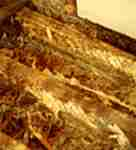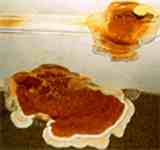

The destruction and deterioration of timber in buildings can be caused by many factors but the most serious and common problem is fungal decay. Dry Rot and Wet Rot are the commonly used terms to describe the decay of wood tissue.
Wet Rot (Coniophora
puteana)
Sometimes called
cellar fungus, wet rot is a common cause of structural defects. It requires
moisture content of 40 - 50% but it does not spread over masonry and growth
is stopped when moisture is removed. Attacked timber is dark brown and
left in small cuboidal splits or longitudinal cracks.
Dry Rot (Serpula
lacrymans)
The true dry
rot fungus is the more serious requiring fast specialist action to avoid
very extensive damage. It is malignant and will spread even through thick
walls in search of timber to attack. Affected timber is brown, dry and
brittle with cuboidal fractures. A 20% moisture level is required for spore
germination and the spores can be seen in the form of


Treatment:
Firstly location and removal of the underlying source of moisture is necessary. Special low odour preservation fluids, generally micro emulsions, are then applied by spray, brush or in paste or gel form. Where necessary infected masonry is drilled, irrigated and surface sprayed.Owen Preservation use specially formulated preservative fluids to carry out the fungicidal process and skilled joiners to carry out the replacement of defective timbers.
Ask for a free estimate by either phoning or E-mailing us.
Tel: 01915810705
Mobile: 07703452801 (day)
[Damp
Proofing][WallTies][Woodworm][Wet
& Dry Rot][Plastering][Basement
Tanking]
[Home]